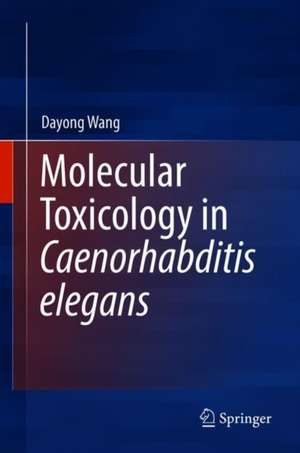Molecular Toxicology in Caenorhabditis elegans
Autor Dayong Wangen Limba Engleză Hardback – 6 feb 2019
Preț: 1303.26 lei
Preț vechi: 1371.86 lei
-5% Nou
Puncte Express: 1955
Preț estimativ în valută:
249.39€ • 266.67$ • 207.93£
249.39€ • 266.67$ • 207.93£
Carte disponibilă
Livrare economică 27 martie-10 aprilie
Preluare comenzi: 021 569.72.76
Specificații
ISBN-13: 9789811336324
ISBN-10: 9811336326
Pagini: 290
Ilustrații: XVIII, 447 p. 285 illus., 211 illus. in color.
Dimensiuni: 155 x 235 mm
Greutate: 0.91 kg
Ediția:1st ed. 2019
Editura: Springer Nature Singapore
Colecția Springer
Locul publicării:Singapore, Singapore
ISBN-10: 9811336326
Pagini: 290
Ilustrații: XVIII, 447 p. 285 illus., 211 illus. in color.
Dimensiuni: 155 x 235 mm
Greutate: 0.91 kg
Ediția:1st ed. 2019
Editura: Springer Nature Singapore
Colecția Springer
Locul publicării:Singapore, Singapore
Cuprins
Molecular Basis for Oxidative Stress Induced by Environmental Toxicants in Nematodes.- Molecular Basis for Reduced Lifespan Induced by Environmental Toxicants or Stresses.- Roles of Oxidative Stress Related Molecular Signals in the Regulation of Toxicity of Environmental Toxicants or Stresses.- Functions of MAPK Signalling Pathways in the Regulation of Toxicity of Environmental Toxicants or Stresses.- Functions of Insulin and the Related Signalling Pathways in the Regulation of Toxicity of Environmental Toxicants or Stresses.- Functions of Development Related Signalling Pathways in the Regulation of Toxicity of Environmental Toxicants or Stresses.- Functions of Cell Death and DNA Damage Related Signalling Pathways in the Regulation of Toxicity of Environmental Toxicants or Stresses.- Functions of Metabolism Related Signalling Pathways in the Regulation of Toxicity of Environmental Toxicants or Stresses.- Functions of Protective Response Related Signalling Pathways in the Regulation of Toxicity of Environmental Toxicants or Stresses.- Functions of G-Protein Coupled Receptors and Ion Channels and the Downstream Cytoplasmic Signals in the Regulation of Toxicity of Environmental Toxicants or Stresses.- Discussion on Specificity of Molecular Signals in Response to Certain Environmental Toxicants or Stresses.- Epigenetic Regulation of Toxicity of Environmental Toxicants or Stresses.- Strategies to Screen and to Identify New Genetic Loci Involved in the Regulation of Toxicity of Environmental Toxicants or Stresses.- Molecular Basis for Adaptive Response to Environmental Toxicants or Stresses.- Molecular Basis for Transgenerational Toxicity Induction of Environmental Toxicants or Stresses.
Notă biografică
Dr. Dayong Wang is a professor at the Medical School, Southeast University, China. He obtained his Ph.D. from Peking University in 2001 and completed his post-doctoral training at the University of Toronto from 2002 to 2004. His research focuses on toxicology and pathology using Caenorhabditis elegans as a model animal, fields in which he has published more than 160 research articles.
Textul de pe ultima copertă
This book will focus on the molecular basis of oxidative stress induced by toxicants or stresses and various molecular signalling pathways in regulating the toxicity of toxicants or stresses in Caenorhabditis elegans. It will also cover the discussion on the aspects of response signals, G-protein coupled receptors and ion channels, specific molecular signals, and epigenetic signals involved in the regulation of toxicity from toxicants or stresses. The molecular basis for adaptive response for transgenerational toxicity of environmental toxicants or stresses will be further discussed. Nematode Caenorhabditis elegans is a classic model animal with well-described genetic and developmental backgrounds based on the study of life science, and has been further successfully and widely used in both toxicity assessment and toxicological study of various environmental toxicants or stresses. Based on related available data, this book aims at providing a systematic understanding of the knowledge system of molecular toxicology in C. elegans.
Caracteristici
Provides a systematic understanding the knowledge system of molecular toxicology in C. elegans
Thoroughly examines the principles of molecular signalling pathways regulating the toxicity of toxicants or stresses in C. elegans
With ample color figures
Thoroughly examines the principles of molecular signalling pathways regulating the toxicity of toxicants or stresses in C. elegans
With ample color figures
